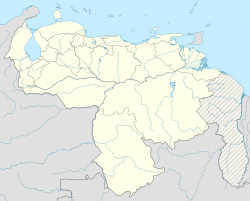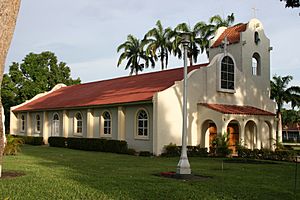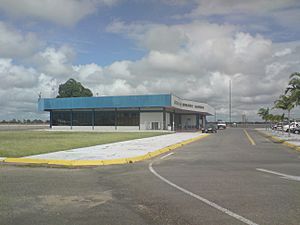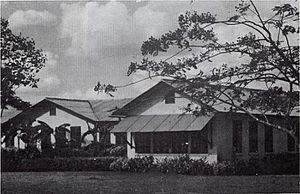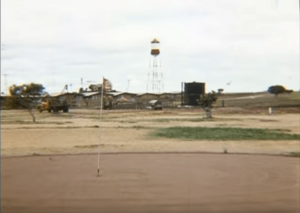San Tomé, Venezuela facts for kids
Quick facts for kids
San Tomé
|
|
|---|---|
| Country | |
| State | Anzoátegui |
| Municipality | Pedro María Freites Municipality |
| Elevation | 255 m (837 ft) |
| Time zone | UTC-4:00 (VET) |
| Climate | Aw |
San Tomé is a town in Venezuela that was built by an oil company. It is located in the state of Anzoátegui, about 8 miles northeast of El Tigre. Another town, San José de Guanipa (also called El Tigrito), is between El Tigre and San Tomé. San Tomé is about 60 miles north of the Orinoco River. It is also about 90 miles south of Puerto la Cruz and its oil refineries on the Caribbean Sea.
San Tomé was first built in the 1930s. It was a planned community for the Mene Grande Oil Company. This company was a part of Gulf Oil Corporation. In 1975, the oil industry in Venezuela became owned by the government. So, Petróleos de Venezuela, Sociedad Anónima (PDVSA) took over San Tomé.
Contents
Geography of San Tomé
San Tomé is in a flat, open area of eastern Venezuela. This area is often called the "Mesa de Guanipa." The town is about 835 feet above sea level. The weather is warm all year, with high temperatures around 88°F and lows around 70°F. Steady winds blow from the east-northeast. Summer is the rainy season, with 4 to 8 inches of rain each month.
The town of San Tomé is about 1 mile wide and 3 miles long. It has two main parts. Campo Norte (North Camp) is where the main offices for PDVSA are. Homes for company staff are also in North Camp. This area is also known as Campo Meneven. Campo Sur (South Camp) is for fun activities and has homes for workers.
San Tomé has its own airport, called San Tomé Airport. It is also known as Don Edmundo Barrios Airport. This airport connects San Tomé, El Tigre, and El Tigrito to other parts of Venezuela. A highway links San Tomé to Puerto la Cruz on the coast. The biggest city to the south is Ciudad Bolivar, located on the Orinoco River.
Oil Discoveries and Development
Oil companies got rights to drill for oil in Anzoátegui State in 1925. In 1927, South American Gulf Company (later Venezuelan Gulf Company) started working in the area. In the 1930s, a large amount of light crude oil was found near El Tigrito. This discovery was made by the Mene Grande Oil Company (MGO).
The oil discovery led to the founding of El Tigre in 1933. A special well, called Oficina No. 1, was started in 1933 and finished in 1937. This well showed that the "Oficina Formation" had a lot of oil. El Tigre quickly grew into a busy oil town. The name "Oficina" came from a telegraph office nearby. The Greater Oficina Area includes many oil fields across a large part of Anzoátegui State.
MGO moved its main office to El Tigre. By 1938, they began building a new company town, San Tomé. All their operations in the region moved there by 1940. A hospital was built in 1941, and schools followed in 1942. A club was built in 1943, a store in 1947, and an electric plant in 1948.
Before oil was found, this area had very few people. By 1940, a road and an oil pipeline connected El Tigre to Puerto La Cruz. Mene Grande also built an oil terminal at Puerto la Cruz. By 1946, the region had produced 127 million barrels of oil. This was important during World War II, as Venezuela supplied oil to the United States.
South of San Tomé, near the Orinoco River, is the "Orinoco Belt." This area has a huge reserve of heavy crude oil. It is the largest oil reserve in the world. Companies explored this area in the 1930s and found this heavy oil. For many years, it was called the "Tar Belt." This oil was too thick to easily get out of the ground. It only became possible to produce it in the 1980s.
Hollis Dow Hedberg, an American geologist, helped Mene Grande find oil around El Tigre. He lived there from 1937 to 1939. From 1939 to 1946, he worked in San Tomé. He was in charge of all geological work for Mene Grande in eastern Venezuela. Later, Hedberg became the chief geologist for Gulf Oil Company. He also taught geology at Princeton University.
Life in the Oil Camp
San Tomé was built like a military base from the late 1930s to the 1950s. E.E. "Gene" Brossard, a manager for MGO, started the town. A Swiss botanist named Henri François Pittier helped provide trees for the town. North Camp was for American staff and offices. South Camp was for Venezuelan workers. It had places for single workers, a store, a dining hall, and club facilities. Company leaders lived on "Jefe Hill."
A golf course, Campo de Golf San Tomé, is just north of the town. A school for children from kindergarten to ninth grade was also built. For many years, a red and white water tower was a famous landmark in the town.
Gene Brossard's daughter, Emma Brossard, lived in San Tomé as a child. She later worked for MGO and raised her family there. She became an expert on the Venezuelan oil industry. In 1946, about 800 people lived in San Tomé. By 1955, about 300 Americans and others worked there.
After Venezuela's government took over the oil industry in 1975, PDVSA owned San Tomé. The town became a busy business center because of PDVSA. In 2006, Venezuela's President Hugo Chávez and Iran's President Mahmoud Ahmadinejad started a joint oil drilling project in San Tomé. This project was between PDVSA and Iran's Petropars.
Education at UNEFA
The Anzoátegui campus of "La Universidad Nacional Experimental Politécnica de la Fuerza Armada Bolivariana" (The National Experimental Polytechnical University of the Bolivarian Armed Forces), or UNEFA, is in San Tomé. This campus is one of 61 in the country. It is located just south of South Camp. UNEFA offers free education in many different career fields. The UNEFA Anzoátegui campus was founded in 2002. It has about 1500 students.
Transportation Hub
San Tomé is served by two airports, making it easy to travel to and from the area:
Notable People from San Tomé
Many interesting people have connections to San Tomé:
- Andrew Divoff (1955–), an American actor and producer.
- Juan Chacín Guzmán, who became President of Petroleos de Venezuela.
- Jaime Lusinchi, a doctor at the San Tomé hospital around 1949. He later became president of Venezuela (1984-1989).
- Mariem Velazco, a beauty queen who won Miss International 2018. She was the eighth Venezuelan to win this title.
- Edward B. Walker III, who became the president and chief operating officer for Gulf Oil Corporation.
See also
 In Spanish: San Tomé (Anzoátegui) para niños
In Spanish: San Tomé (Anzoátegui) para niños


